Papercuts and Silhouettes(2)
2009-02-26 17:39:56 作者:phpcms 來源: 瀏覽次數(shù):1291 網(wǎng)友評論 0 條
|
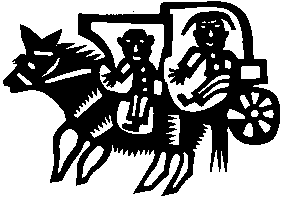 It is popular in Huiming Prefecture, Shandong Province and used as window ornament and embroidery pattern. It is more coarse than that of Jiaodong. It is characterized by folded figurine. It is popular in Huiming Prefecture, Shandong Province and used as window ornament and embroidery pattern. It is more coarse than that of Jiaodong. It is characterized by folded figurine.
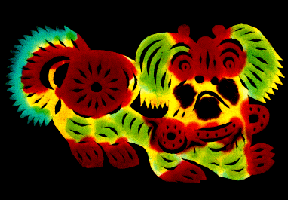 It is popular in Wei County, Hebei Province. It is famous for its window ornaments, of which Tianpiliang is the earliest form. This ornament is made by drawing and dyeing pictures on the thin chip. Then a type of water-printed woodblock window paper-cutting, originated in Wuqiang County in the same province, drew upon this feature in colour and transparency and came to unite with Shuipiliang window paper-cutting, which is characterized by the engraving instead of writing.Thus the distinctive feature of Wei County paper-cutting came into being. It is popular in Wei County, Hebei Province. It is famous for its window ornaments, of which Tianpiliang is the earliest form. This ornament is made by drawing and dyeing pictures on the thin chip. Then a type of water-printed woodblock window paper-cutting, originated in Wuqiang County in the same province, drew upon this feature in colour and transparency and came to unite with Shuipiliang window paper-cutting, which is characterized by the engraving instead of writing.Thus the distinctive feature of Wei County paper-cutting came into being.
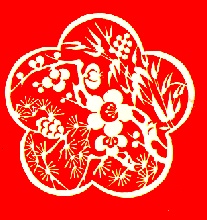 This type of paper-cutting is famous for its happy flower and Douxiang flower types. On the occasions of wedding and celebrations, Nanjingers like to decorate the dowry with paper-cutting artifacts made from scarlet red paper. Its pattern is filled up with propitious illustrations according to need and particular paper shapes. There are flower-in-flower, theme-in-theme and subtlety-in-brevity patterns. Deftness is highlighted in the naivety. The themes of Douxiang paper-cutting range from dramatic tales, historical legends, folklores to propitious patterns and flowers. This type of paper-cutting is famous for its happy flower and Douxiang flower types. On the occasions of wedding and celebrations, Nanjingers like to decorate the dowry with paper-cutting artifacts made from scarlet red paper. Its pattern is filled up with propitious illustrations according to need and particular paper shapes. There are flower-in-flower, theme-in-theme and subtlety-in-brevity patterns. Deftness is highlighted in the naivety. The themes of Douxiang paper-cutting range from dramatic tales, historical legends, folklores to propitious patterns and flowers.
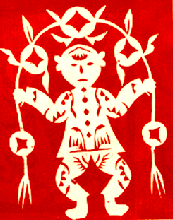 It is widely spread in Xuzhou, Jiangsu Province, particularly in Pi County. Its first type is colourful gate label. This type of paper -cutting is mainly used for decorating the windows. Its themes run the gamut of labouring scenes, domesticated animals, folklores, historical tales, etc. It is widely spread in Xuzhou, Jiangsu Province, particularly in Pi County. Its first type is colourful gate label. This type of paper -cutting is mainly used for decorating the windows. Its themes run the gamut of labouring scenes, domesticated animals, folklores, historical tales, etc.
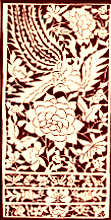 It is a type of Miao Nationality paper-cutting in Taijiang, Guizhou Province. It acts as the embroidery draft for decorating sleeve, girdle and hat. Though its themes are also dragon and phoenix, and peony, it is quitely distinguished from that of Han Nationality. Especially its paper-cutting for decoration sleeve is embroidered by needle and characterized by its fineness in roughness. It is a type of Miao Nationality paper-cutting in Taijiang, Guizhou Province. It acts as the embroidery draft for decorating sleeve, girdle and hat. Though its themes are also dragon and phoenix, and peony, it is quitely distinguished from that of Han Nationality. Especially its paper-cutting for decoration sleeve is embroidered by needle and characterized by its fineness in roughness.
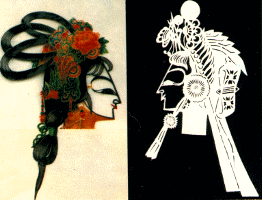 First it refers to the leather silhouette in Luan County, Hebei Province. Its performance was accompanied by the song sung in the tone of luoting. It also refers to the shadow play accompanied by the song sung in the tone of Liuqin Opera. Its engraving skill was characterized by roughness and antiquated colour. First it refers to the leather silhouette in Luan County, Hebei Province. Its performance was accompanied by the song sung in the tone of luoting. It also refers to the shadow play accompanied by the song sung in the tone of Liuqin Opera. Its engraving skill was characterized by roughness and antiquated colour.
|
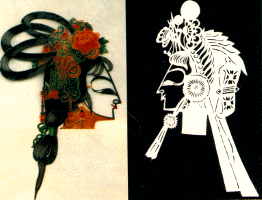 |
重點閱讀
查看心情排行您看到此篇文章时的感受是:

支持
高兴
震惊
愤怒
无奈
谎言
枪稿
不解
搞笑
无聊
标题党
2
顶一下2
踩一下
顶一下2
踩一下
[錯誤報告] [推薦] [收藏] [打印] [關(guān)閉] [返回頂部]

 已有
已有













